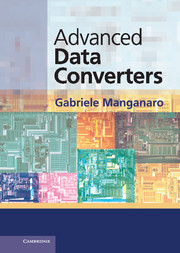1 - The need for data converters
Published online by Cambridge University Press: 05 January 2012
Summary
Modern electronic systems process and store information digitally. However, due to the analog nature of the world, conversion from analog to digital and/or from digital to analog is, and always will be, inevitable and performed by data converters: Analog-to-digital converters (ADCs) and digital-to-analog converters (DACs).
Depending on a variety of factors, including technical specifications, system partitioning, and market needs, data converters can be either integrated on the same chip, or on the same package, together with other analog or digital blocks, or they can be stand-alone. Most stand-alone data converters are part of the $13–$16 billion standard analog market which also includes amplifiers, comparators, and interface and power management devices. In fact, data converters constitute 16% of this market, but they are growing at a faster rate than the other components, second only to power management devices [1, 2], with unit shipments going from about 2.9 billion units in 2010 to an estimated volume of about 4.7 billion units by 2015. That does not account for the embedded data converters [3] integrated together with digital signal processors (DSPs) in a wide variety of applications ranging from consumer electronics (e.g. audio devices, cell phones, imaging devices, DVD and multi-media players etc.) to automotive (e.g. embedded controllers), process control, and instrumentation.
This chapter will briefly outline some of the applications of data converters, illustrating the pervasiveness and variety of ADCs and DACs in modern predominantly digital signal processing systems.
Information
- Type
- Chapter
- Information
- Advanced Data Converters , pp. 1 - 15Publisher: Cambridge University PressPrint publication year: 2011
Accessibility standard: Unknown
Why this information is here
This section outlines the accessibility features of this content - including support for screen readers, full keyboard navigation and high-contrast display options. This may not be relevant for you.Accessibility Information
- 1
- Cited by
